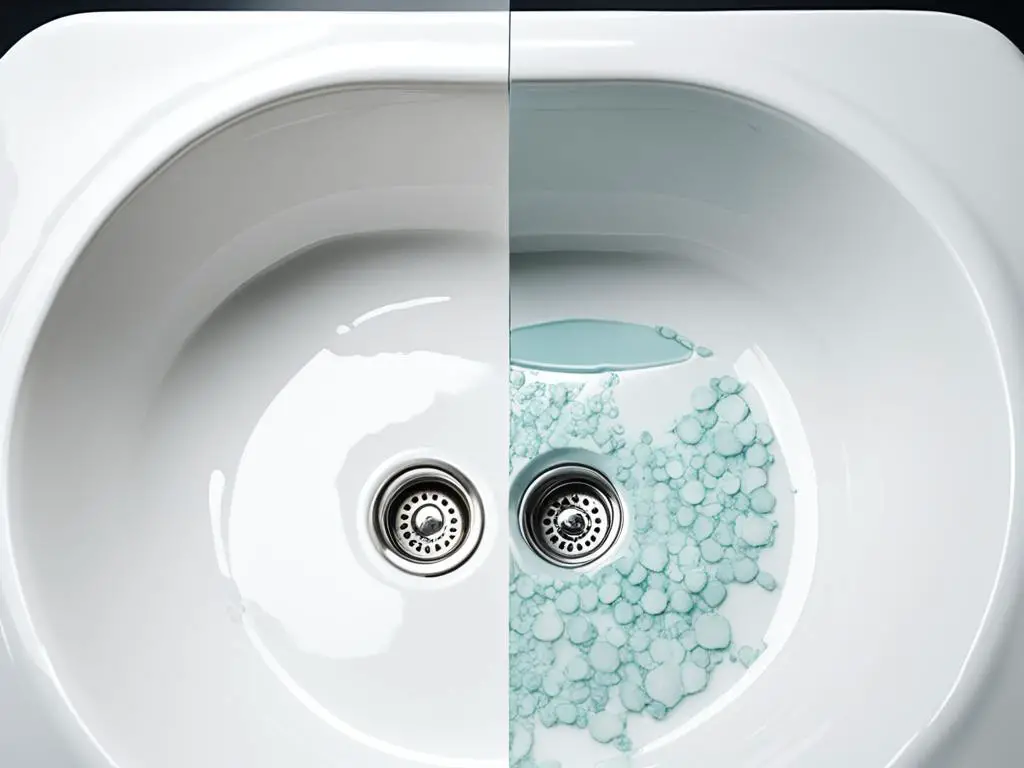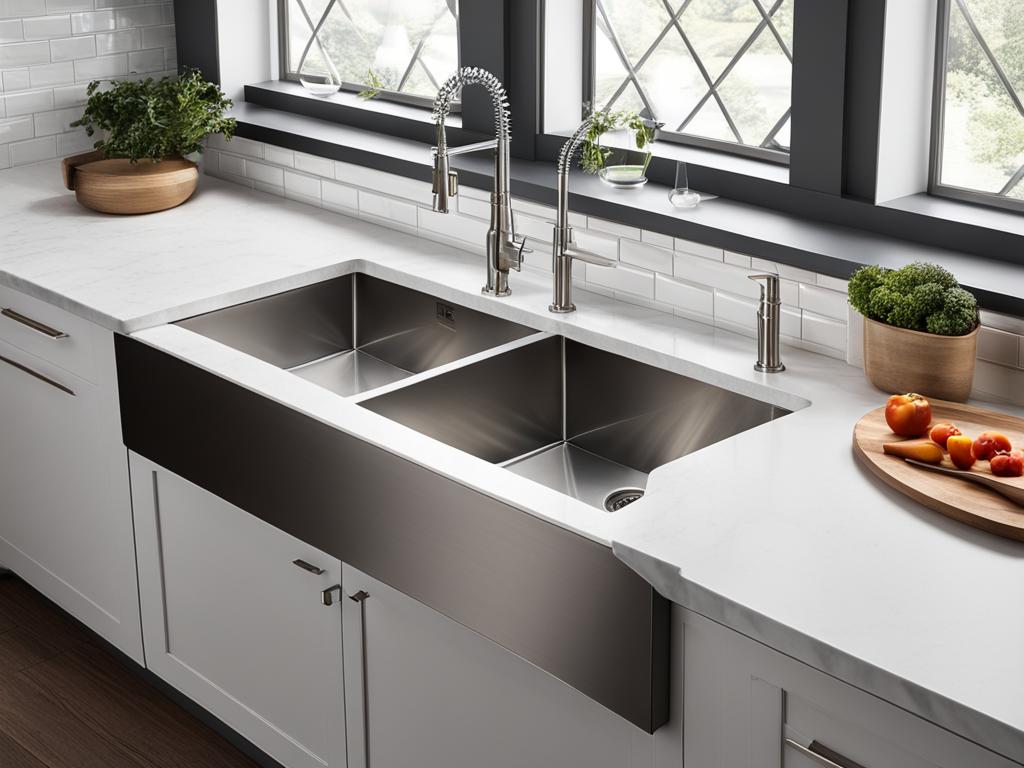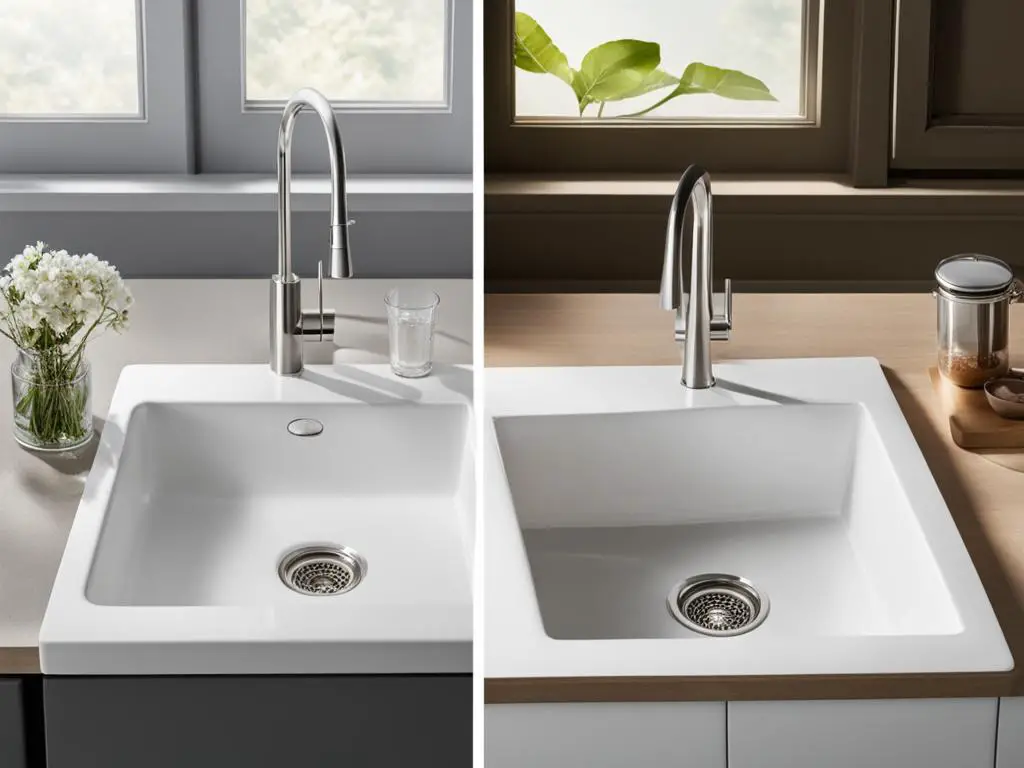When it comes to choosing the right material for your kitchen sink, white and stainless steel are two popular options. Each material has its own set of characteristics and features that can impact your decision. Let’s dive into the pros and cons of white sinks and stainless steel sinks to help you make an informed choice.
White sinks offer a classic and timeless appeal. They can enhance the aesthetic of your kitchen, especially if you have a farmhouse-style design. However, white sinks can be prone to staining and require regular cleaning to maintain their pristine appearance. On the other hand, stainless steel sinks are durable, resistant to corrosion, and easy to clean. They can complement modern kitchen styles and are available in various finishes to suit your preferences.
Key Takeaways:
- White sinks provide a classic and timeless look for your kitchen.
- Stainless steel sinks offer durability and easy maintenance.
- White sinks can be prone to staining and require regular cleaning.
- Stainless steel sinks are resistant to corrosion and come in various finishes.
- Consider your kitchen style and maintenance preferences when choosing between white and stainless steel sinks.
Pros and Cons of Porcelain Sinks
Porcelain sinks are a popular choice for homeowners looking to add an elegant and traditional touch to their kitchen. With a glossy or shiny finish, porcelain sinks offer a sleek and stylish look that can complement a variety of kitchen designs. Available in various colors and styles, such as a porcelain farmhouse sink, they allow for greater customization and personalization.
One of the key advantages of porcelain sinks is their strength and durability. Made from a combination of clay, feldspar, and quartz, they are designed to withstand regular use and can last for decades with proper care. Their durability makes them an excellent investment for homeowners who want a sink that will stand the test of time.
However, it is important to consider the potential drawbacks of porcelain sinks as well. Porcelain sinks can be prone to chipping and cracking upon impact, especially when heavy objects are dropped into them. The nature of the material also makes porcelain sinks heavier and more challenging to install compared to stainless steel sinks, requiring additional support and reinforcement.
Another factor to consider is that porcelain sinks can stain easily if not cleaned regularly. While porcelain sinks are generally resistant to most household stains, substances like coffee, tea, and red wine can leave noticeable marks if left unattended. Regular cleaning and maintenance are necessary to keep porcelain sinks looking their best.
Additionally, it’s worth noting that porcelain sinks tend to be more expensive than stainless steel sinks. The materials used in their construction and the craftsmanship required to create their elegant designs contribute to their higher price point. Homeowners on a tight budget may need to weigh the aesthetic appeal of porcelain sinks against the additional cost.
| Pros of Porcelain Sinks | Cons of Porcelain Sinks |
|---|---|
| – Elegant and traditional look | – Prone to chipping and cracking |
| – Available in various colors and styles | – Heavier and more challenging to install |
| – Strong and durable | – Can stain easily if not cleaned regularly |
While there are some downsides to consider, porcelain sinks remain a popular choice for those seeking a classic and timeless kitchen aesthetic. With their range of colors and styles, durability, and elegant appearance, porcelain sinks can elevate the overall appeal of any kitchen.

Porcelain vs Stainless Steel Sink: Choosing the Right Option
When deciding between a porcelain sink and a stainless steel sink, it ultimately comes down to personal preference and the specific needs of your kitchen. Porcelain sinks offer a luxurious and traditional look but require more careful maintenance and can be more expensive. On the other hand, stainless steel sinks are more affordable, durable, and easier to clean, but may not provide the same level of elegance and style.
Consider your kitchen’s design, your budget, and the level of maintenance you are willing to commit to when making your decision. Both options have their advantages and disadvantages, and it’s crucial to weigh them against your individual requirements to find the sink that best suits your needs.
Pros and Cons of Stainless Steel Sinks
Stainless steel sinks are a popular choice for many homeowners due to their affordability and compatibility with modern stainless steel appliances and decor themes. They offer a sleek and contemporary look to any kitchen, making them a versatile option for various styles.
One of the advantages of stainless steel sinks is their durability. They are resistant to cracking, corrosion, and wear and tear, ensuring that they can withstand heavy daily use without losing their functionality and appearance. Stainless steel sinks have a long lifespan, making them a cost-effective investment for your kitchen.
However, like any material, there are some downsides to consider. Stainless steel sinks are susceptible to scratches caused by sharp objects. While these scratches may not affect the functionality of the sink, they can be visible and may require regular maintenance and care to minimize their appearance.
Another consideration is the noise factor. Stainless steel sinks can be noisier than their porcelain counterparts when dishes and utensils come into contact with the metal surface. This can be mitigated by using soundproofing techniques during installation or by opting for sinks with special insulation features.
To maintain the pristine appearance of a stainless steel sink, it is important to dry the surface after use to prevent water spots and mineral deposits. Regular cleaning with mild soap and a non-abrasive cloth is usually sufficient to keep the sink looking clean and shiny.
Design Options
When it comes to design options, stainless steel sinks generally have a limited range compared to other materials. They are typically available in a single color, reflecting the classic and timeless stainless steel finish. While this may limit some design choices, it also ensures that the sink seamlessly blends with different kitchen styles and color schemes.
Overall, stainless steel sinks offer a balance of affordability, durability, and modern aesthetics. They are a reliable choice for homeowners seeking a versatile and long-lasting sink option for their kitchen.
Comparison: Stainless Steel vs. Porcelain Sinks
| Pros of Stainless Steel Sinks | Cons of Stainless Steel Sinks |
|---|---|
| 1. Affordability | 1. Susceptible to scratches |
| 2. Durability and corrosion resistance | 2. Noisier than porcelain sinks |
| 3. Versatile design that matches various styles | 3. Limited design options |
Appearance of White Sinks and Stainless Steel Sinks
When it comes to the appearance of kitchen sinks, white sinks and stainless steel sinks offer distinct styles and aesthetics. Let’s explore their visual features in more detail.
Porcelain Sink Appearance
Porcelain sinks, also known as ceramic or Vitreous China sinks, have a smooth or undulating appearance, adding a touch of elegance to any kitchen. One of the highlights of porcelain sinks is the availability of various colors, allowing you to choose the one that best complements your kitchen’s design. Whether you opt for a traditional white porcelain sink or a bold color to make a statement, these sinks provide a classic and timeless look.

Stainless Steel Sink Appearance
In contrast, stainless steel sinks offer a modern and sleek appearance. They come in different finishes, such as polished or brushed, allowing you to choose the one that matches your kitchen’s style. With options for clean lines or rounded edges, stainless steel sinks can seamlessly blend into any contemporary kitchen design. One advantage of stainless steel sinks is their ability to hide scratches and water spots better than porcelain sinks, maintaining a cleaner and more polished look over time.
Installation, Maintenance, and Durability of White Sinks and Stainless Steel Sinks
When it comes to installing white sinks and stainless steel sinks, there are a few key differences to consider. White sinks, particularly porcelain sinks, require additional mounting hardware and are generally heavier to install compared to stainless steel sinks. Therefore, it’s important to ensure that your countertop can support the weight of a white sink before installation.
On the other hand, stainless steel sinks are generally lighter and easier to install. They often come with convenient mounting systems that make the installation process straightforward.
Now, let’s talk about maintenance. Porcelain sinks can be cleaned using mild abrasive cleansers to remove stains or grime. However, it’s advisable to avoid harsh chemicals or scrubbing pads that may damage the porcelain surface. To maintain the durability of a porcelain sink, it’s crucial to protect it from chipping or staining by avoiding dropping heavy or sharp objects into it.
Stainless steel sinks, on the other hand, are relatively low maintenance. They can be easily cleaned with mild soap and water or a gentle cleaning solution. It’s important to avoid using abrasive materials or harsh chemicals that can scratch or corrode the stainless steel surface. To keep your stainless steel sink looking its best, be sure to dry it after each use to prevent water spots.
“Proper maintenance is essential to extend the lifespan of your sink.”
Both white sinks and stainless steel sinks offer durability, but they have different characteristics. Porcelain sinks are known for their durability, but they are prone to chipping or cracking if subjected to heavy impacts. On the other hand, stainless steel sinks are resistant to cracking, corrosion, and general wear and tear, making them a durable choice for kitchen sinks.

Conclusion
When it comes to choosing between a white sink and a stainless steel sink, there are several factors to consider. Your personal preferences, kitchen style, and budget should all play a role in your decision-making process. Both white sinks and stainless steel sinks have their own set of advantages and disadvantages, so it’s essential to prioritize the features that matter most to you.
If you’re looking for an elegant and traditional look, a white sink, such as a porcelain sink, may be the right choice for you. Porcelain sinks offer a glossy or shiny finish and are available in various colors and styles, including farmhouse sinks. However, it’s important to note that porcelain sinks can be more challenging to install, prone to chipping and cracking, and require regular cleaning to avoid staining.
On the other hand, if affordability and durability are your top priorities, a stainless steel sink is worth considering. Stainless steel sinks are lighter and easier to install than porcelain sinks. They are resistant to cracking, corrosion, and wear and tear. Additionally, stainless steel sinks are easy to clean and maintain, although they can be scratched by sharp objects and may be noisier when washing dishes.
In the end, the best choice for your kitchen sink ultimately depends on your individual needs and preferences. Take into account factors such as appearance, installation requirements, maintenance, and durability to make an informed decision. Whether you opt for the timeless elegance of a white sink or the affordability and durability of a stainless steel sink, make sure it aligns with your kitchen style and budget to enhance your overall kitchen experience.
FAQ
What are the pros and cons of porcelain sinks?
Porcelain sinks offer an elegant and traditional look, lasting for decades. However, they can chip and crack upon impact, stain easily if not cleaned regularly, and are more expensive than stainless steel sinks.
What are the pros and cons of stainless steel sinks?
Stainless steel sinks are affordable and resistant to cracking, corrosion, and wear and tear. However, they can be easily scratched by sharp objects, may require drying to prevent water spots, and have limited design options.
How do porcelain sinks and stainless steel sinks differ in appearance?
Porcelain sinks have a smooth or undulating appearance and are available in various colors, providing a classic and elegant look. Stainless steel sinks have a modern and sleek appearance with options for clean lines or rounded edges, available in different finishes.
How is the installation, maintenance, and durability of porcelain sinks different from stainless steel sinks?
Porcelain sinks require additional mounting hardware, are heavier to install, and should be protected from chipping and staining. They can be cleaned with mild abrasive cleansers. Stainless steel sinks are lighter and easier to install, are easy to clean and maintain, and can resist scratching and water spots better.
What factors should I consider when choosing between a white sink and a stainless steel sink?
Consider your personal preferences, kitchen style, and budget. Porcelain sinks offer an elegant and traditional look, while stainless steel sinks are more affordable and durable. The best choice for your kitchen sink depends on your individual needs and preferences.



